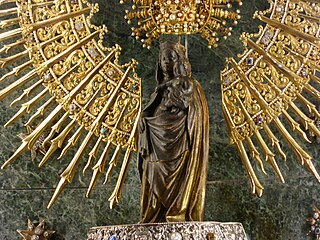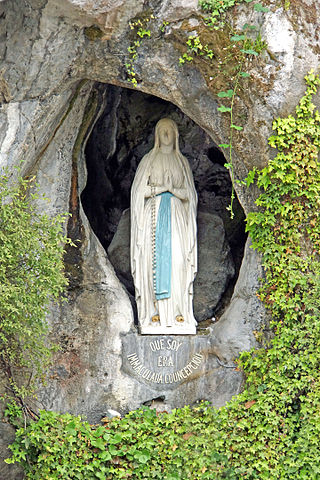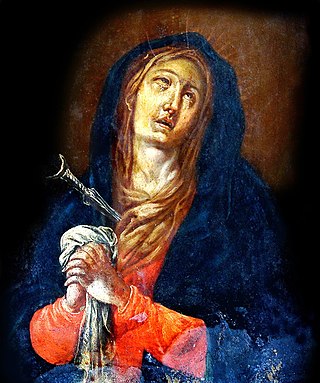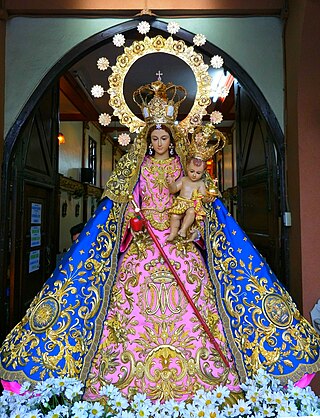
Our Lady of Sorrows, Our Lady of Dolours, the Sorrowful Mother or Mother of Sorrows, and Our Lady of Piety, Our Lady of the Seven Sorrows or Our Lady of the Seven Dolours are names by which Mary, mother of Jesus, is referred to in relation to sorrows in life. As Mater Dolorosa, it is also a key subject for Marian art in the Catholic Church.

Our Lady of the Pillar is the name given to the Blessed Virgin Mary in the context of the traditional belief that Mary, while living in Jerusalem, supernaturally appeared to the Apostle James the Greater in AD 40 while he was preaching in what is now Spain. Those who adhere to this belief consider this appearance to be the only recorded instance of Mary exhibiting the mystical phenomenon of bilocation. Among Catholics, it is also considered the first Marian apparition, and unique because it happened while Mary was still living on Earth.

San Andres, officially the Municipality of San Andres, is a 3rd class municipality in the province of Catanduanes, Philippines. According to the 2020 census, it has a population of 38,480 people.

Our Lady of Lourdes is a title of the Virgin Mary. She is venerated under this title by the Roman Catholic Church due to her apparitions that occurred in Lourdes, France. The first apparition of 11 February 1858, of which Bernadette Soubirous told her mother that a "Lady" spoke to her in the cave of Massabielle while she was gathering firewood with her sister and a friend. Similar apparitions of the "Lady" were reported on 18 occasions that year, until the climax revelation in which she introduced herself as: "the Immaculate Conception". On 18 January 1862, the local Bishop of Tarbes Bertrand-Sévère Laurence endorsed the veneration of the Blessed Virgin Mary in Lourdes.

Our Lady of San Juan de los Lagos is a Roman Catholic title of the Blessed Virgin Mary venerated by Mexican and Texan faithful. The original image is a popular focus for pilgrims and is located in the state of Jalisco, in central Mexico, 122 kilometers (76 mi) northeast of the city of Guadalajara. The statue is venerated both in Mexico and in the United States where it is known by its proxy title Nuestra Señora de San Juan del Valle, mainly focused in Texas.

Our Lady of Sorrows of Turumba is a Marian title, a venerated Marian icon and image associated to the Our Lady of Sorrows, The town of Pakil in the province of Laguna considers her as its patroness.

Our Lady of Manaoag is a Roman Catholic title of the Blessed Virgin Mary venerated in Manaoag, Pangasinan, the Philippines. The sacred statue is referred to as Apo Baket in the native language of local devotees.

The Our Lady of Remedies Parish, also known as Malate Church, is a Roman Catholic parish church in the district of Malate in the city of Manila, Philippines. This Mexican Baroque-style church is overlooking Plaza Rajah Sulayman and, ultimately, Manila Bay. The church is dedicated to Nuestra Señora de los Remedios, the patroness of childbirth. A revered statue of the Virgin Mary in her role as Our Lady of Remedies was brought from Spain in 1624 and stands at the altar.
Our Lady of Charity is a celebrated Marian title of the Blessed Virgin Mary venerated in many Catholic countries.

The Diocesan Shrine of Nuestra Señora del Buen Suceso / The Cathedral - Parish of St. Andrew, also known as Parañaque Cathedral or Saint Andrew's Cathedral, is one of the oldest Roman Catholic churches in the Philippines, located in Parañaque City, Metro Manila. Established on May 11, 1580 by the Spanish Augustinians, it is, at present, the seat of the Diocese of Parañaque, which comprises the cities of Parañaque, Las Piñas, and Muntinlupa.

Our Lady of Peñafrancia is an image of the Blessed Virgin Mary. A Marian image is permanently enshrined in the Minor Basilica of Our Lady of Peñafrancia in Naga, Camarines Sur.

The Basilica of Our Lady of Scherpenheuvel is a Roman Catholic parish church and minor basilica in Scherpenheuvel-Zichem, Belgium. The church was consecrated in 1627 and raised to the status of a minor basilica in 1922. It is reputedly the most frequently visited shrine of pilgrimage in Belgium. While the cult on the Scherpenheuvel is older, its present architectural layout and its enduring importance are due to the patronage of the Archdukes Albert and Isabella and the Counter-Reformation.

Our Lady of Piat is a 16th-century Roman Catholic icon of the Blessed Virgin Mary enshrined in a minor basilca situated in Piat, Cagayan, Philippines. It is the town's and the province's patroness and is one of the most venerated Marian images of Mary in the Philippines, referred to as the "Mother of Cagayan".

The Our Lady of Guidance is a 16th-century image of the Blessed Virgin Mary depicted as the Immaculate Conception and widely venerated by Filipinos. The wooden Black Madonna is considered the oldest extant Marian statue in the Philippines. Locally venerated as patroness of navigators and travelers, the image is enshrined at the Ermita Church in the city of Manila.

Our Lady of Salvation, also known as Our Lady of Light, is a Catholic title of the Blessed Virgin Mary. The devotion to Our Lady of Salvation is based on a wooden statue of the Virgin Mary that was first venerated in Joroan in the Philippines.

Our Lady of the Good Event of Parañaque (Spanish: Nuestra Señora del Buen Suceso de Parañaque; Filipino: Ina ng Mabuting Pangyayari ng Parañaque is the name of a statue of the Madonna and Child enshrined in St. Andrew's Cathedral in Parañaque, Philippines. The original Spanish name is often incorrectly rendered in English as Our Lady of Good Success due to the superficial similarity between the Spanish word "suceso" and the English false friend "success."

The Immaculate Conception Parish Church is the oldest Roman Catholic church in the municipality of Los Baños, Laguna, Philippines. Its titular is the Nuestra Señora del Aguas Santas and its feast is celebrated every December 8. The church is under the jurisdiction of the Diocese of San Pablo.

Our Lady of Aránzazu and is a Roman Catholic title of the Blessed Virgin Mary.

The Our Lady of the Rosary of Orani, or simply Our Lady of Orani, refers to the reputed Marian apparition of the Blessed Virgin Mary in both the towns of Orani and Samal in Bataan, as well as the image associated with the event.

The Our Lady of the Visitation of Guibang, is a 20th-century Roman Catholic icon enshrined in the town of Gamu in the province of Isabela, Philippines. It is considered to be one of the most venerated Marian images in northern Philippines. The statue was Episcopally Crowned by the Most Rev. Carmine Rocco, Papal Nuncio to the Philippines on 26 May 1973. As closing of the Diocesan Marian Congress of that same year. The Coronation was held at St. Ferdinand College, beside the St. Ferdinand Cathedral in Ilagan, Isabela.






















